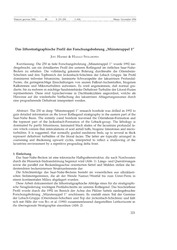Das lithostratigraphische Profil der Forschungsbohrung „Münsterappel 1"
Zeitschrift: Mainzer geowissenschaftliche Mitteilungen, 199423: 221 - 228
Haneke, Jost; Stollhofen, Harald, 1994: Das lithostratigraphische Profil der Forschungsbohrung „Münsterappel 1". In: Mainzer geowissenschaftliche Mitteilungen, Band 23: 221 - 228, DOI: https://doi.org/10.23689/fidgeo-5656.
 |
Dokument öffnen: |
Die 250 m tiefe Forschungsbohrung „Münsterappel 1" wurde 1992 niedergebraeht,
um ein detailliertes Profil des unteren Rotliegend im östlichen Saar-Nahe-
Becken zu erhalten. Die vollständig gekernte Bohrung durchteufte die Odernheim-
Schichten und den Topbereich der Jeckenbach-Schichten der Lebach Gruppe. Im Profil
dominieren teilweise bituminöse, laminierte Schwarzpelite der lakustrinen Profundal-
Fazies, die geringmächtige Einschaltungen von sauren Fallout-Aschentuffen, biogenen
Kalksteinen und Mikroturbiditen aufweisen. Es wird angenommen, daß normal gradierte,
bis zu mehrere m mächtige Sandsteinbänke Deltafront-Turbidite der Litoral-Fazies
repräsentieren. Diese sind typischerweise in Dachbankzyklen angeordnet, welche als
Hinweise auf die wiederholte Verflachung des lakustrinen Ablagerungsraumes durch
eine progradierende Deltafront interpretiert werden. Abstract: The 250 m deep "Münsterappel 1" research borehole was drilled in 1992 to
gain detailed information on the lower Rotliegend stratigraphy in the eastern part of the
Saar-Nahe Basin. The entirely cored borehole traversed the Odernheim-Formation and
the topmost part of the Jeckenbach-Formation of the Lebach-group. The lithology is
dominated by partly bituminous, laminated black shales of the lacustrine profundal fades
which contain thin intercalations of acid airfall tuffs, biogenic limestones and microturbidites.
It is suggested, that normally graded sandstone beds, up to several m thick
represent deltafront turbidites of the litoral facies. The latter are typically arranged in
coarsening and thickening upward cycles, interpreted to reflect a shallowing of the
lacustrine environment by a repetitive prograding delta front.

